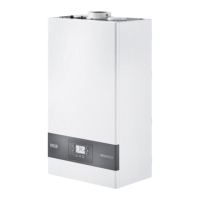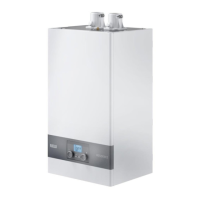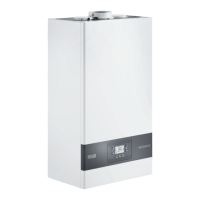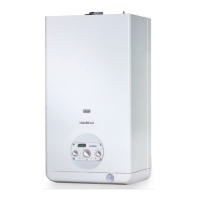46
SHUTDOWN
5.5 Cleaning the boiler
9
DANGER: Risk to life from electric shock!
− Before opening a unit: disconnect electrical power and lock
to prevent accidental reactivation.
9
WARNING: System damage!
− Do not use abrasive cleaning pads or powder detergents.
9
NOTICE:
The combustion chamber and ues must be cleaned periodically
- at least once a year - by a qualied technician.
Clean the boiler and remove any carbon deposits from the surfac-
es of the heat exchanger at least once a year. This not only ex-
tends the boiler’s working life, but also keeps it efcient in terms
of heat output and consumption.
− Open the door (1) and pull out the turbulators (2).
− Use a ue brush (3) or other suitable tool to clean inside the
combustion chamber and the ue gas pipes.
1
− Open the inspection port (4) and clean out any deposits
from inside the ue gas box.
If more thorough cleaning is required:
− Remove the outer panels.
− Unscrew the xing bolts and pull rmly on the ue gas box
(5) to remove it from the boiler.
− Check at regular intervals that the condensate drain (6) is
not blocked.
− If necessary, replace the gasket (7).
− Clean all removed components, then follow the above
steps in the reverse order to ret them.
6
4
5
7
5.6 External cleaning
Clean the outside of the boiler casing with a soft cloth damped in
soapy water.
To remove stubborn marks, use a cloth damped in a 50% mix of
water and denatured alcohol or a suitable cleaning product.
Dry the boiler after cleaning it.
0
Do not use abrasive products, petrol or triethylene.
5.7 Checking and correcting the water pressure
The heating system must contain sufcient water to safeguard its
correct function.
− If the water pressure in the heating system is too low, top
up with water.
Check the water pressure monthly.
When should you check the water pressure in the heating sys-
tem?
The ll and top-up water quality must comply with the water re-
quirements in this manual.
Air pockets may form in the heating system through the ll or top-
up water releasing gases.
− Vent the heating system (e.g. bleeding the radiators).
− If required, top up with water
Recently added ll or top-up water loses much of its volume in
the rst few days because it releases gases. With new systems you
should therefore initially check the heating water pressure on a
daily basis, and then at gradually longer intervals.
Once the heating system is hardly losing any volume, check the
heating water pressure monthly.
A distinction is generally made between open vented and sealed
unvented systems. In practice, open vented systems are hardly
installed nowadays. We will therefore be using a sealed unvent-
ed heating system to demonstrate how you can check the water
pressure. All settings will have already been made by the installa-
tion engineer when the system was rst commissioned.
Sealed unvented systems
9
NOTICE: System damage through frequent topping up.
Subject to the water quality, your heating system can be
damaged through corrosion or scaling.
− Ensure that the heating system is vented correctly.
− Check the heating system for leaks and the expansion ves-
sel for functionality.
− Observe the requirements regarding water quality.
− If water loss occurs frequently, locate the cause and rectify
the problem without delay.
9
NOTICE: System damage through temperature stresses.
− Only ll the heating system when cold (the ow tempera-
ture must not exceed 104 °F (40 °C)).
− During operation, only ll the heating system via the ll
valve in the heating system pipework (return).
For sealed unvented systems, the pressure gauge needle should
be near the mid point of the gauge. The red needle of the pressure
gauge must be set to the pressure required for the heating system.
− Check the heating system water pressure.
− Top up with water via the lling valve in the heating system
pipework.
− Vent the heating system.
− Check the water pressure once more.
